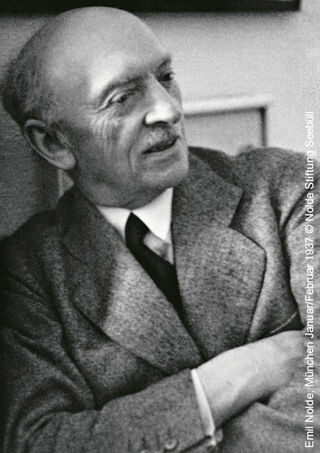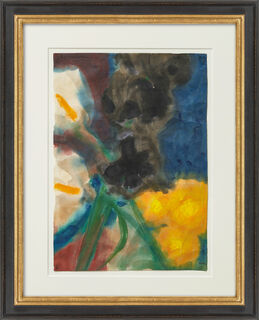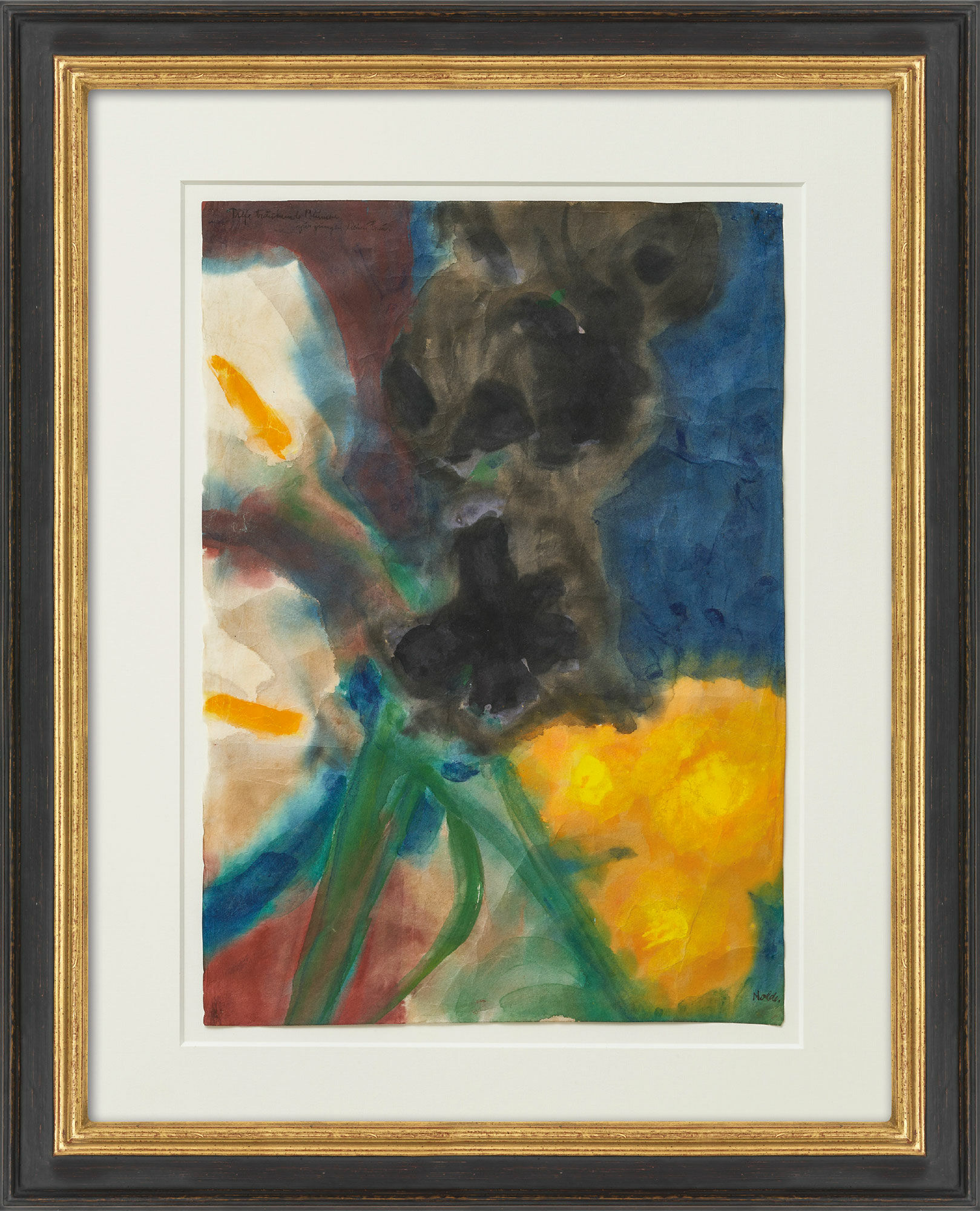Picture "Deep Dreaming Flowers to the Young Dear Woman" (1947) (Unique piece)


Picture "Deep Dreaming Flowers to the Young Dear Woman" (1947) (Unique piece)
Quick info
unique piece | signed | watercolour on Japanese paper | framed | size 68.5 x 53.5 cm
Detailed description
Picture "Deep Dreaming Flowers to the Young Dear Woman" (1947) (Unique piece)
The watercolour presented here is striking in its composition, reminiscent of the fragmentary nature of modern photographs, as well as the varying degrees of focus on the depicted flowers and the almost abstract imagery. The artist added the dedication "Deep dreaming flowers to the young dear woman" at the upper left corner of the picture and gave it to Jolanthe Erdmann.
Nolde met the 26-year-old student in 1947, the year this watercolour was painted and married her a year later. The artist described his second wife as "lively and clever, deep-thinking and art-loving".
The work presented here is of museum quality and, at the same time, represents a biographical testimony of the painter and graphic artist.
Watercolour on Japanese paper, c. 1947, signed. An expert's report by Prof. Dr. Manfred Reuther is available. Motif size/sheet size 47 x 33.5 cm. Size in frame 68.5 x 53.5 cm as shown.

About Emil Nolde
1867-1956 - German Expressionist
Emil Nolde was born as Hans Emil Hansen and named himself after his birthplace in 1902. Nolde is considered one of the most important German Expressionists. When he was rejected by the Munich Academy of Fine Arts, he moved to Paris to study at the Académie Julien. Starting in 1905 he lived and worked on the Danish island of Alsen and in Berlin and was a member of the revolutionary expressionist group "Die Brücke" (The Bridge) for a short time and of the Berlin Secession.
Shortly after Nolde left the artists' association "Die Brücke" at the end of 1907, he met the Norwegian painter Edvard Munch in Berlin, whose work impressed him greatly. During the visit of his friend Hans Fehr in 1908, he began to discover the technique of watercolour painting and finally how to realise it with virtuosity.
Today, Nolde's oeuvre includes numerous watercolour works, oil paintings, graphic works and several sculptures. His intensive use of colour is characteristic. Although the artist always remained figurative in his motifs (e.g. landscapes, flowers, city scenes, religious motifs), he "composed" his pictures entirely from colour. When Nolde moved into his brick house "Seebüll" in Neukirchen in northern Germany in 1927, he surrounded it with a large garden that offered him motifs in abundance.
Research had long noted that Nolde's position on National Socialism was problematic. His exclusion from the Reich Chamber of Fine Arts was associated with a ban on exhibitions, sales and publications. Nolde repeatedly sought rehabilitation and recognition as a state artist. However, he was denied this right up until the end. His painting was simply not formally compatible with the ideas of the Nazis.
At the opening of the infamous exhibition "Degenerate Art", 48 of his works were shown, and more than 1000 works were confiscated. However, due to his contacts, Nolde was able to retrieve a large part of these works.
Despite his active adherence to the system, he was banned from working from 1941 on. However, his ban didn't include a general ban on painting, as was often reported later. During the war, he produced more than 1000 of the so-called "unpainted pictures" in the privacy of his home. The term originally referred to the function of these small-format watercolours as studies and preliminary sketches that were not turned into large paintings. After 1945, these undoubtedly artistically charming pieces and their naming contributed to the mystification of Nolde as a persecuted artist.
Despite the contradictory ideological positions of Nolde as a person, the artistic value of his work remains undisputed to this day. The way Nolde manages to let the colour of an oil painting or aquarelle glow from within is unrivalled.
Works by Emil Nolde can be found in the collections of high-ranking museums worldwide, including the Art Institute in Chicago, the Hermitage Museum in St. Petersburg, the Museum of Modern Art in New York City, the Brücke Museum in Berlin, the Albertina in Vienna and the Kunstmuseum in Basel, etc. Moreover, foundations have been established in his honour in Seebüll and Berlin.
Paintings with glazing watercolours, that are characterised by their transparency, which let deeper layers and painting surfaces shine through.
Often the paper surface is omitted. This contributes significantly to the effect of the work. The aquarelle painting requires skilful use of colour, as it dries quickly and corrections are almost impossible.
A one-of-a-kind or unique piece is a work of art that has been personally created by the artist. It exists only once due to the type of production (oil painting, watercolours, drawing, etc.).
In addition to the classic unique pieces, there exist the so-called "serial unique pieces". They present a series of works with the same colour, motif and technique, manually prepared by the same artist. The serial unique pieces are rooted in "serial art", a type of modern art, that aims to create an aesthetic effect through series, repetitions and variations of the same objects or themes or a system of constant and variable elements or principles.
In the history of arts, the starting point of this trend was the work "Les Meules" (1890/1891) by Claude Monet, in which for the first time a series was created that went beyond a mere group of works. The other artists, who addressed to the serial art, include Claude Monet, Piet Mondrian and above all Gerhard Richter.


